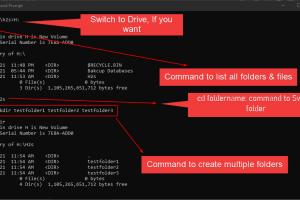Unlock Your Computer's Secrets: How to See Every File on Your Computer in CMD

-
Quick Links:
- Introduction
- Understanding CMD (Command Prompt)
- Preparations Before Using CMD
- Basic CMD Commands
- Navigating Files Using CMD
- Advanced CMD Techniques
- Case Studies
- Common Issues and Troubleshooting
- Expert Insights
- FAQs
Introduction
Welcome to the ultimate guide on how to see every file on your computer using CMD (Command Prompt). In a world where graphical user interfaces dominate, the Command Prompt remains a powerful tool that can unlock a treasure trove of information about your system. Whether you are a tech enthusiast, a system administrator, or just someone curious about their computer, mastering CMD can significantly enhance your file management capabilities.
Understanding CMD (Command Prompt)
The Command Prompt, or CMD, is a command-line interpreter application available in most Windows operating systems. It allows users to execute various commands to perform advanced administrative tasks, troubleshoot issues, and automate processes. Unlike graphical interfaces, CMD is text-based, which may appear daunting at first, but it offers unmatched speed and versatility.
Why Use CMD?
- Speed: CMD allows for quicker navigation and file management.
- Automation: Scripts can be created to automate tasks.
- Control: More granular control over system settings and files.
Preparations Before Using CMD
Before diving into CMD, it's essential to understand the basics and prepare your environment.
- Accessing CMD: You can access CMD by typing "cmd" in the Windows search bar and hitting Enter.
- Running as Administrator: For certain commands, you might need elevated privileges. Right-click on CMD and select "Run as administrator."
- Familiarize with CMD Interface: Understand the layout and how to enter commands effectively.
Basic CMD Commands
Here are some essential commands you need to know to start exploring your files.
- DIR: Lists all files and directories in the current directory.
- CD: Changes the directory. For example,
CD Documentswill take you to the Documents folder. - CLS: Clears the screen for better readability.
Example of Basic Commands
C:\> DIR C:\> CD Documents C:\Documents> DIR
Navigating Files Using CMD
Once you have a grasp on the basic commands, navigating through your files becomes easier.
Changing Drives
To change drives, simply type the drive letter followed by a colon. For example:
C:\> D: D:\>
Listing All Files
To see all files, including hidden ones, use:
DIR /A
Advanced CMD Techniques
For those who want to dive deeper, here are some advanced techniques.
Using Wildcards
Wildcards allow you to specify groups of files. For example, DIR *.txt will list all text files.
Redirecting Output
You can redirect command output to a text file using the greater than symbol. For example:
DIR > filelist.txt
Case Studies
Let's explore some real-world applications of CMD for file management.
Case Study 1: System Administrators
System administrators often use CMD to automate backups. By creating batch scripts, they can schedule regular backups without manual intervention.
Case Study 2: File Recovery
In instances where users accidentally delete files, CMD can be used to navigate through system directories and recover files from backup locations.
Common Issues and Troubleshooting
Even experienced users can run into issues when using CMD. Here are some common problems and their solutions.
- Permission Denied: Ensure you are running CMD as an administrator.
- Files Not Found: Double-check the directory and file names for typos.
Expert Insights
According to tech experts, mastering CMD can save time and increase productivity. As technology progresses, having a foundational knowledge of command-line interfaces will be invaluable.
FAQs
- 1. What is CMD?
- CMD, or Command Prompt, is a command-line interpreter in Windows for executing commands.
- 2. How do I open CMD?
- Type “cmd” in the Windows search bar and press Enter.
- 3. What is the DIR command?
- DIR lists all files and directories in the current location.
- 4. Can I see hidden files using CMD?
- Yes, use the command
DIR /Ato view hidden files. - 5. How do I change directories in CMD?
- Use the
CDcommand followed by the folder name. - 6. What are wildcards in CMD?
- Wildcards are symbols used to replace or represent one or more characters in commands.
- 7. Can CMD help with file recovery?
- Yes, it can navigate directories to locate backups or deleted files.
- 8. Is CMD available on all Windows versions?
- Yes, CMD is available on all modern Windows operating systems.
- 9. Can I automate tasks with CMD?
- Yes, you can create batch files to automate repetitive tasks.
- 10. What should I do if I encounter errors?
- Check the command syntax and ensure you have the necessary permissions.
Random Reads
- How to open arf file
- How to open and read pdfs on ipad
- How to remove contact paper
- How to remove default system apps android
- How to safely clear cached files on your mac
- How to paint fiberglass chairs
- How to paint fiberglass
- Mastering hard disk drive platter swaps
- How to test your ps4 controller
- How to test your lcd display on android